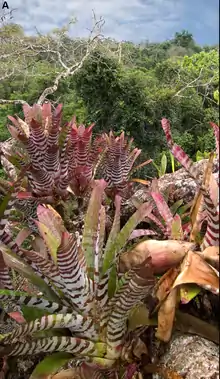Zimmerman's poison frog
Zimmermann's poison frog (Ranitomeya variabilis), also referred to as the variable poison frog, is a small species of poison dart frog known from the upper Huallaga River drainage of San Martín Region, Peru.[1][4] It also occurs in western Brazil (Amazonas), Colombia (Amazonas, Caquetá, Putumayo and Vaupés), Ecuador (Morona-Santiago, Napo, Orellana, Pastaza and Sucumbíos).[5] It is semi-arboreal, living in the forest understory and canopy.[4] Like other poison frogs, it contains alkaloid poisons. The mimic poison frog is a Müllerian mimic of this species.[4]
| Zimmerman's poison frog | |
|---|---|
.jpg.webp) | |
| Scientific classification | |
| Kingdom: | Animalia |
| Phylum: | Chordata |
| Class: | Amphibia |
| Order: | Anura |
| Family: | Dendrobatidae |
| Genus: | Ranitomeya |
| Species: | R. variabilis |
| Binomial name | |
| Ranitomeya variabilis | |
| Synonyms | |
| |
The species was formerly considered to be synonym of Ranitomeya ventrimaculata.[2]

Parental care and competition
Ranitomeya variabilis has male-only parental care and there seems to be no pair bonding with frequent partner switching. Instead, pairs of mates deposit the eggs in small water filled cavities (phytotelma) in plants. Later as the tadpoles are hatching the male carries them on his back individually into separate phytotelma; tadpoles are separated because they are cannibalistic. The male is able to distinguish which phytotelma have other offspring by using chemical cues therefore assuring that multiple offspring are not placed in the same phytotelma. However, in other cases parental care has been non-existent forcing competition amongst siblings in food resources but also survival. Tadpoles typically feed on each other, other eggs, or nearby food. Additional evidence of competition has been seen in tadpoles which, when left alone in a phytotelma, would actively approach a frog in order to out-compete the other tadpoles in leaving the phytotelma.[6]
References
- Javier Icochea, Karl-Heinz Jungfer (2004). "Ranitomeya variabilis". IUCN Red List of Threatened Species. 2004: e.T55207A11266499. doi:10.2305/IUCN.UK.2004.RLTS.T55207A11266499.en. Retrieved 20 November 2021.
- Frost, Darrel R. (2015). "Ranitomeya variabilis (Zimmermann and Zimmermann, 1988)". Amphibian Species of the World: an Online Reference. Version 6.0. American Museum of Natural History. Retrieved 18 June 2015.
- Gifkikkerportaal
- Monique Sanchez; Rebecca Knapp & Andrea Bondelie (2012). "Ranitomeya variabilis (Zimmermann and Zimmermann, 1988)". AmphibiaWeb. Retrieved 24 September 2016.
- "Ranitomeya variabilis (Zimmermann and Zimmermann, 1988) | Amphibian Species of the World". amphibiansoftheworld.amnh.org. Retrieved 2020-11-12.
- Schulte, Liza Maria; Mayer, Michael. "Poison frog tadpoles seek parental transportation to escape their cannibalistic siblings." Journal of Zoology 303, no. 2 (2017): 83-89. https://doi.org/10.1111/jzo.12472
